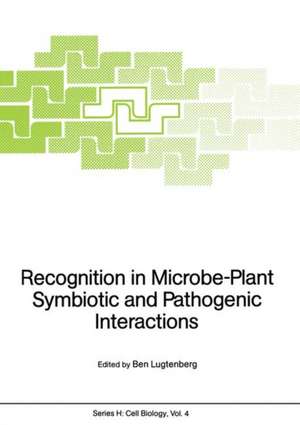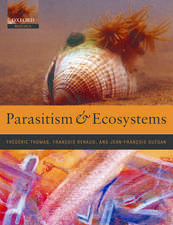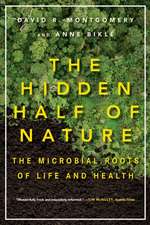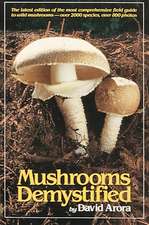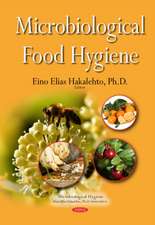Recognition in Microbe-Plant Symbiotic and Pathogenic Interactions: Nato ASI Subseries H:, cartea 4
Editat de Ben Lugtenbergen Limba Engleză Paperback – 25 noi 2011
Din seria Nato ASI Subseries H:
- 18%
 Preț: 953.82 lei
Preț: 953.82 lei -
 Preț: 393.13 lei
Preț: 393.13 lei - 15%
 Preț: 643.34 lei
Preț: 643.34 lei - 15%
 Preț: 643.34 lei
Preț: 643.34 lei - 15%
 Preț: 641.03 lei
Preț: 641.03 lei - 15%
 Preț: 642.83 lei
Preț: 642.83 lei - 15%
 Preț: 642.51 lei
Preț: 642.51 lei - 5%
 Preț: 712.81 lei
Preț: 712.81 lei -
 Preț: 392.97 lei
Preț: 392.97 lei - 15%
 Preț: 651.02 lei
Preț: 651.02 lei - 15%
 Preț: 640.24 lei
Preț: 640.24 lei - 18%
 Preț: 948.61 lei
Preț: 948.61 lei - 15%
 Preț: 655.92 lei
Preț: 655.92 lei - 15%
 Preț: 655.92 lei
Preț: 655.92 lei - 15%
 Preț: 653.14 lei
Preț: 653.14 lei - 15%
 Preț: 650.19 lei
Preț: 650.19 lei - 15%
 Preț: 655.13 lei
Preț: 655.13 lei - 15%
 Preț: 652.17 lei
Preț: 652.17 lei - 15%
 Preț: 675.58 lei
Preț: 675.58 lei - 18%
 Preț: 958.07 lei
Preț: 958.07 lei - 18%
 Preț: 961.41 lei
Preț: 961.41 lei - 18%
 Preț: 970.56 lei
Preț: 970.56 lei - 5%
 Preț: 1100.30 lei
Preț: 1100.30 lei - 5%
 Preț: 376.43 lei
Preț: 376.43 lei - 15%
 Preț: 650.86 lei
Preț: 650.86 lei - 15%
 Preț: 644.63 lei
Preț: 644.63 lei - 15%
 Preț: 655.60 lei
Preț: 655.60 lei - 18%
 Preț: 963.47 lei
Preț: 963.47 lei - 15%
 Preț: 648.42 lei
Preț: 648.42 lei - 5%
 Preț: 731.43 lei
Preț: 731.43 lei - 15%
 Preț: 653.14 lei
Preț: 653.14 lei - 18%
 Preț: 960.13 lei
Preț: 960.13 lei - 18%
 Preț: 968.34 lei
Preț: 968.34 lei - 18%
 Preț: 953.97 lei
Preț: 953.97 lei - 15%
 Preț: 654.95 lei
Preț: 654.95 lei - 15%
 Preț: 652.49 lei
Preț: 652.49 lei - 15%
 Preț: 650.86 lei
Preț: 650.86 lei - 5%
 Preț: 367.64 lei
Preț: 367.64 lei - 5%
 Preț: 1104.68 lei
Preț: 1104.68 lei - 18%
 Preț: 953.20 lei
Preț: 953.20 lei - 15%
 Preț: 647.27 lei
Preț: 647.27 lei - 15%
 Preț: 653.00 lei
Preț: 653.00 lei - 15%
 Preț: 656.25 lei
Preț: 656.25 lei - 18%
 Preț: 962.35 lei
Preț: 962.35 lei - 15%
 Preț: 644.82 lei
Preț: 644.82 lei - 15%
 Preț: 666.55 lei
Preț: 666.55 lei - 15%
 Preț: 642.68 lei
Preț: 642.68 lei - 15%
 Preț: 645.96 lei
Preț: 645.96 lei - 15%
 Preț: 651.84 lei
Preț: 651.84 lei
Preț: 651.99 lei
Preț vechi: 767.05 lei
-15% Nou
Puncte Express: 978
Preț estimativ în valută:
124.78€ • 129.78$ • 103.01£
124.78€ • 129.78$ • 103.01£
Carte tipărită la comandă
Livrare economică 14-28 aprilie
Preluare comenzi: 021 569.72.76
Specificații
ISBN-13: 9783642716546
ISBN-10: 3642716547
Pagini: 468
Ilustrații: XIII, 449 p.
Dimensiuni: 170 x 244 x 25 mm
Greutate: 0.74 kg
Ediția:Softcover reprint of the original 1st ed. 1986
Editura: Springer Berlin, Heidelberg
Colecția Springer
Seria Nato ASI Subseries H:
Locul publicării:Berlin, Heidelberg, Germany
ISBN-10: 3642716547
Pagini: 468
Ilustrații: XIII, 449 p.
Dimensiuni: 170 x 244 x 25 mm
Greutate: 0.74 kg
Ediția:Softcover reprint of the original 1st ed. 1986
Editura: Springer Berlin, Heidelberg
Colecția Springer
Seria Nato ASI Subseries H:
Locul publicării:Berlin, Heidelberg, Germany
Public țintă
ResearchCuprins
I. Recognition in Nodulation by Rhizobium.- Genetic analysis of Rhizobium-plant interactions.- Respective roles of common and specific Rhizobium meliloti nod genes in the control of lucerne infection.- Infection mutants of Rhizobium meliloti are altered in acidic exopolysaccharide production.- Intercellular communication and recognition in the Rhizobium-legume symbiosis.- Promoters and operon structure of the nodulation region of the Rhizobium leguminosarum symbiosis plasmid pRL1JI.- Manipulation of nodulation specificity in the pea-Rhizobium leguminosarum symbiosis.- Bradyrhizobium japonicum genes involved in soybean root-nodule development.- Nodulation of soybean: Bradyrhizobium japonicum physiology and genetics.- Attachment of Rhizobium leguminosarum to pea root hair tips.- Specificity of Rhizobium(Galega) — Galega-interaction.- Flavones induce expression of the nodulation genes in Rhizobium.- Induction of Rhizobium nod genes by flavonoids: differential adaptation of promoter, nodD gene and inducers for various cross-inoculation groups.- Induction of Rhizobium leguminosarumnod genes by flavonoids is antagonized by other plant-specified aromatic compounds.- Fractionation of Rhizobium leguminosarum cells into outer membrane, cytoplasmic membrane, periplasmic and cytoplasmic components.- A study of surface interactions between Rhizobium bacteroids and the peribacteroid membrane using monoclonal antibodies.- Nodulins involved in early stages of pea root nodule development.- II. Recognition in Pathogen — Plant Interaction.- Pathogenic strategies of fungi.- The molecular basis of the Agrobacterium-plant interaction — Characteristics of Agrobacterium virulence genes and their possible occurrence in other plant-associated bacteria.- T-region transfer from Agrobacteriumtumefaciens to plant cells: functional characterization of border repeats.- Cloning of DNA sequences from Azospirillum brasilense, homologous to Rhizobium nod genes and Agrobacterium vir genes.- Attachment of Agrobacterium tumefaciens to plant host cells.- Role of fimbriae and pili in the attachment of Klebsiella, Enterobacter and Pseudomonas to plant surfaces.- Race specific resistance to Bremia lactucae is expressed by lettuce cells in suspension culture.- Interaction of fungal polygalacturonase with plant proteins in relation to specificity and regulation of plant defense response.- A model system for the study of fungus — host surface interactions: adhesion of Phytophthora megasperma to protoplasts and mesophyll cells of soybean.- Ultrastructural studies of surface interactions during adhesion and infection by ericoid endomycorrhizal fungi.- Structural modifications of the fungal wall before and during VAM symbiosis.- III. Recognition in Plant Defence.- Occurrence of race-specific elicitors in the host pathogen interaction tomato-Cladosporium fulvum.- Studies on the role of carbohydrates in host-microbe interactions.- Biochemical interactions of plants with potentially pathogenic fungi.- Stimulation of phytoalexin formation in fungus-infected plants and elicitor-treated cell cultures of parsley.- Recognition and response in plant: pathogen interactions.- Phytoalexin synthesis in soybean following infection of roots with Phytophthora megasperma or treatment of cell cultures with fungal elicitor.- Elicitation of indole alkaloid biosynthesis in periwinkle.- Expression of plant genes in the hypersensitive reaction of French bean (Phaseolus vulgaris) to the plant pathogenic bacterium Pseudomonas syringae pv. phaseolicola.- Hydroxyproline-rich glycoproteins (HRGPs) ininfected plants: signaling, accumulation and gene expression.- IV. Recognition in Biological Crop Pest Control.- A model genetically engineered pesticide: cloning and expression of the Bacillus thuringiensis subsp. Kurstaki ? -endotoxin into Pseudomonas fluorescens.- Molecular aspects of plant growth affecting Pseudomonas species.- The iron-uptake system of the plant-growth-stimulating Pseudomonas putida WCS358: genetic analysis and properties and structure analysis of its siderophore.- Role of flagella of the plant growth stimulating Pseudomonas fluorescens isolate WCS374 in the colonization of potato roots.- Conditions in the rhizosphere in relation to microbial development.- V. Recommendations for Future Research and Applications.- Consensus and perspective on Rhizobium.- Prospects for novel plant disease control rationales.- Plant-Agrobacterium interaction.- Recognition, elicitors and the hypersensitive reaction.- Molecular analysis of plant defence mechanisms.
